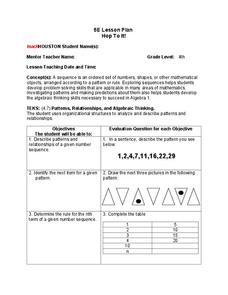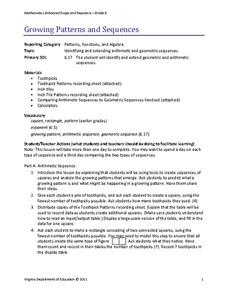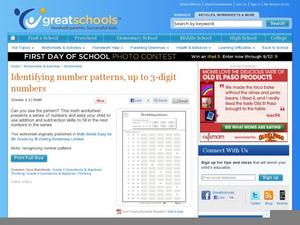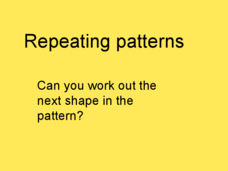Curated OER
Transformations in the Coordinate Plane
Your learners connect the new concepts of transformations in the coordinate plane to their previous knowledge using the solid vocabulary development in this unit. Like a foreign language, mathematics has its own set of vocabulary terms...
Curated OER
Fibonacci Number Patterns
In this patterns worksheet, 11th graders identify and solve 3 different problems that include completing Fibonacci number patterns. First, they continue the pattern shown at the top to find more Fibonacci numbers. Then, students...
Curated OER
Shapes and Patterns in Art and Oceans
First graders draw, cut out, and design their own fish shapes by cutting out shapes and putting them together. In this shapes and patterns worksheet, 1st graders also construct a stamp and print patterns with stamps to repeat a...
Super Teacher Worksheets
Snowman Sequencing
Who knew that building snowmen could be educational as well as a ton of fun! This two-part learning exercise first asks learners to cut out and glue in the correct order a series of four pictures showing a child building a snowman. When...
Curated OER
Patterns to the Rescue
Students identify different numbers and letters. They state the patterns in different sequences. They compare answers as a class.
Curated OER
Hop To It!
Students determine patterns. In this mathematics lesson, students act out a skit, play a sequence game, and complete patterns. Students use problems solving skills.
Virginia Department of Education
Growing Patterns and Sequences
Learners explore, discover, compare, and contrast arithmetic and geometric sequences in this collaborative, hands-on activity. They build and analyze growing patterns to distinguish which kind of sequence is represented by a set of data...
Curated OER
Number Patterns
Which number comes next? The great part about this number sequencing instructional activity is that it increases in difficulty so some learners who aren't challenged by the first few will definitely meet their match with the last couple....
Curated OER
Multiplication Sequences
For this math worksheet, students learn that a sequence is a set of numbers which follows a mathematical rule. Students look at math sequences and fill in the missing numbers and also explain in words what the pattern is. Some of the...
Curated OER
Patterns
Follow the pattern to find what comes next. Youngsters analyze shape patterns to continue the sequence in the provided space. The three patterns increase in difficulty, and then scholars have a chance to create two of their own....
Curated OER
Three Number Sequences Worksheets
Test your learners' number line skills with these sequences, which they must finish and then indicate if they are ascending or descending. Numbers range from negative numbers to decimals. This activity would be a great teaching tool for...
Curated OER
Recognizing and Extending Number Sequences
Kids work to recognize and extend number sequences. They determine the rule in order to find the missing number in each sequence given. They review the concept, practice finishing sequences with a calculator, and explain each rule.
Curated OER
Finding Patterns
What's the pattern? Learners skip count to complete 12 sequences, some of which increase and some of which decrease. As they solve each number pattern they count by 2, 3, 4, 5, 6, 10, and 100, getting some extra subtraction and addition...
Curated OER
Extending Geometric Patterns
Which square comes next? Each of these sequences is made up of patterned squares in a continuing order. Learners examine more squares to choose which one(s) would correctly continue the pattern. None of these have very complex sequences;...
Curated OER
Identifying Patterns
Find the pattern! Eighteen number sequences challenge scholars to identify and complete the pattern, adding at least four digits to the given numbers. All the sequences here involve skip counting by various single-digit numbers,...
Curated OER
Sequences
In these math worksheets, students will complete 3 pages of sequencing work. The first page is Simple Sequences (17 problems). The second page is Harder Sequences (18 problems). The third page is Fibonacci Sequence work (9 problems).
Curated OER
Comparing Arithmetic and Geometric Sequences
In this algebra learning exercise, learners analyze patterns and identify it as arithmetic, geometric, or neither. There are 30 questions with answers.
Curated OER
Sequencing
Are you looking for a way to teach sequence of events in your narrative writing unit? Bring this lesson to your middle school class, as it prompts young writers to create a narrative sequence map of events that have happened at school...
Curated OER
Picking Patterns
In this pattern worksheet, students enumerate the number of objects that comes next in the sequence including triangles, blocks, and circles. There are 6 questions.
Curated OER
Patterns, Relations, and Functions: Geometric Shapes
Students explore patterns involving objects or figures and geometric shapes. They identify the missing shapes in patterns and discuss what would come next in the pattern, analyze patterns using different objects, and complete a...
Curated OER
Identify Patterns
To complete these number patterns mathematicians must determine by what number each is constantly increasing. However, this isn't your typical skip counting; scholars count by numbers like 18, 60, and even 101 to fill in the missing...
Curated OER
Repeating Patterns
Pattern recognition is a very important skill to foster in younger children. It helps boost algebraic reasoning, logical reasoning, and mathematical reasoning skills. Here are 11 different shape patterns for learners to complete. They...
Curated OER
Terms in a Sequence
In this terms in a sequence worksheet, students solve and complete 32 various types of problems. First, they simplify each of the equations listed. Then, students find the number of arrangements found using the information given. They...
Curated OER
Identifying Patterns
Although this fractions exercise may seem difficult at first, it's really quite simple and intended for beginners to mixed numbers. Scholars complete 15 number sequences by adding two or three mixed numbers or decimal numbers. However,...























